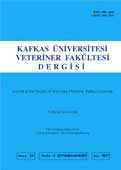
This journal is licensed under a Creative Commons Attribution-NonCommercial 4.0 International License
Kafkas Üniversitesi Veteriner Fakültesi Dergisi
2017 , Vol 23 , Issue 5
Using Cell-free Matrix Derived from Ostrich Plantar Ligament for Repair of Articular Cartilage Defect of Rabbit
1 Department of Clinical Sciences, Faculty of Specialized Veterinary Sciences, Science and Research Branch, Islamic Azad University, Tehran - IRAN2Department of Pathology, Faculty of Specialized Veterinary Sciences, Science and Research Branch, Islamic Azad University, Tehran - IRAN DOI : 10.9775/kvfd.2017.17506 Articular cartilage lesions are most common injury of the knee for which several repair methods have been described. We described in-vivo potential of collagen type I scaffold extracted fromknee of ostrich. Full thickness defects were created bilaterally in the weight bearing area of femoral condyles of the both femurs of 7 white New zealand adult male rabbits weighting 1800±100 g. The six left medial condyles as experimental group I were filled by using cell-free tissue and six right medial condyles of the same rabbit were treated by cell-tissue as experimental group II and the right medial condyle defect of one rabbit as control group was left without treatment. Histopathology data demonstrated significant difference between three groups with respect to the cartilage repair indicators as the morphology of the cells, color matrix and cartilage thickness (P<0.05). Furthermore, sub-chondral bone formation showed a significant difference and relationship between two experimental groups and control group (P<0.05). The use of cell-free ligamentum plantar matrix showed markedly significant improvement in the processes of joint cartilage repair compared control group (P<0.05). Results support the use of cell-free ligamentum plantar can be useful and promising bio-engineering procedure as a scaffold for the treatment of the articular cartilage surface. Keywords : Cell-free matrix, Ostrich plantar ligament, Repair, Articular cartilage defect, Rabbit










